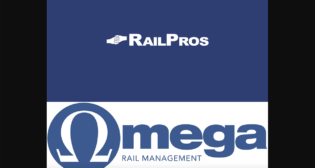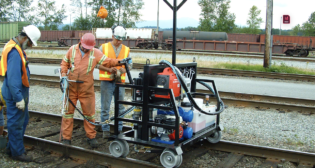
Friction control for better productivity
Written by William C. Vantuono, Editor-in-ChiefGauge-face, top-of-rail, mobile, wayside: it’s not so much the method as the end result
Gone are the days where greasing the track passed for a decent friction modification program. While today’s railroads control friction by the kind of lubricant used, where that lubricant is applied, and how it is applied, today’s friction modifiers and delivery systems are focused on being technologically advanced, environmentally friendly, and cost-conscious.
Biobased friction modifiers
The University of Northern Iowa’s National Ag-Based Lubricants Center has been working on biobased versions of friction modifiers since 1991 and is now working on the second generation of biobased greases as friction modifiers. The UNI/NABL-developed greases are currently commercially available on the market through various sources.
“These products are based on specific fatty acids derived from vegetable oils that are specifically suited for use as gauge-face lubricants. As compared to late 1990s when we introduced biobased based rail curve greases using vegetable oils (not individual fatty acids), the current products are superior in performance, and most important, can be price competitively with conventional greases as long as petroleum prices are over $80/barrel. We believe this will be the greatest help to the railroads when environmentally friendly greases can meet performance requirements and not cost more,” says Dr. Lou Honary, founding director of UNI/NABL Center and president of Environmental Lubricants Manufacturing, Inc.
“Biobased friction modifiers have gone through 20 years of actual commercial development. They offer superior friction reduction performance due to naturally higher lubricity of vegetable oils. Because of their polarity, bio oils adhere to metal surfaces tenaciously and provide high thin film strength. As a result, in general, less friction modifier is needed to perform the same protection and metal-to-metal separation,” says Honary.
Finding balance
The L.B. Foster Friction Management team reports several examples of new developments that are helping the railway industry do “more with less.”
According to Kevin Oldknow, vice president, technology and business development, “First is the introduction of a significant advancement in the chemistry of trackside-applied top-of-rail friction modifiers. Our KELTRACK® Enhanced Retentivity (ER) TOR friction modifier technology incorporates a major step forward in film retentivity, which refers to the ability of the dry thin-film friction modifier to withstand the temperatures and pressures at the wheel/rail interface. In heavy haul freight settings, this improvement is yielding a 50% reduction in the volume of friction modifier that needs to be applied to deliver benefits in rail and wheel life, fuel savings, rolling contact fatigue mitigation, lateral/vertical forces, and track infrastructure asset life. The results are a significant reduction in operating cost, the ancillary benefits associated with major reductions in shipping and logistics, and a doubling of wayside unit refilling intervals. This technology has now been deployed across a number of revenue service territories and we are enthusiastic about the benefits that it brings to the industry.
“Second is the expanded use of train-mounted AutoPilot™ TOR application systems. These systems make use of autonomous, GPS-based controls to dispense friction modifier at the TOR/wheel tread interface, with an intelligent control system that compensates for territories, routes, direction of travel, speed, and curvature, with the ability to finely tune application strategies using a geo-fencing approach to achieve the desired set of benefits (again including fuel, rail/wheel, and infrastructure savings). The net result is an extremely precise and efficient application of friction modifier materials, in which the thin film is applied at the exact application rate desired for each track segment. By making use of Remote Performance Monitoring (RPM) technology, the AutoPilot systems are also able to provide continuous, accurate status updates regarding tank levels and equipment performance to allow for efficient and effective planning of maintenance and filling activities at coordinated locations in the network.
“Finally, the introduction of a new class of wayside measurement devices is allowing for integration with remote monitoring technologies that offers major advantages in verifying system performance and efficiently allocating maintenance resources. Our Salient Systems team has developed a new Lateral/Vertical Force Measurement Module. This is a self-contained, rail-bound module that operates for several years on an internal battery and communicates summary Lateral/Vertical force information wirelessly through our RPM platform. Since TOR friction control produces significant, predictable reductions in lateral forces, this allows for effective verification of TOR friction control performance over a territory at a fraction of the cost of more complex wayside measurement sites. By monitoring lateral/vertical forces at several locations throughout a territory, the ongoing effectiveness of friction management programs can be continuously monitored and maintenance resources can be deployed efficiently in response to any variations in conditions. These measurement modules also provide the ability to assess the impacts of a range of variables on track infrastructure, including train speed (vs. superelevation) and distributed power configurations.”
All in the application
“We are launching an improved applicator bar for gauge-face lubrication,” says Eric Nieman, railway product manager at Lincoln Lubrication Systems. “This applicator bar was developed based upon the success of our patented Pump To Port® design and lube maintainer feedback. The bar has the same pump to port technology and can be installed quickly by only one person. As more railroads realize the benefits of wayside lubrication, it emphasizes lubricator ‘up-time.’ Applicator bars that are easy to remove and re-install during rail maintenance give lube maintainers a fighting chance when dealing with tight track maintenance windows.”
Lincoln’s Pump To Port technology, says Nieman, allows for precise application of TOR and GF material both in location and volume. “Our high-pressure system eliminates port clogging and minimizes waste, thereby economizing in the use of expensive material. High-pressure systems also allow for higher viscosity (thicker) greases to be pumped. Higher viscosity greases adhere to the rail and wheels more effectively, resulting in greater lubricant carry distances. The benefit to the customer is a clean application, a reduced number of wayside lubricators required, and reduced material usage,” says Nieman.
Productivity in partnership
Loram Maintenance of Way Inc. and Tranergy Corporation entered into a definitive agreement for Loram to acquire all assets of Tranergy in mid-September.
As a subsidiary of Loram, Tranergy, Inc. will continue to manufacture and expand its line of friction management products, including CurvGlide™ top-of-rail friction management systems, SwitchEnhancer™ switch lubrication devices, and YardGlide® for friction modification in yards.
Tranergy, Inc., also offers TracGlide®, a train-mounted TOR friction management system that features the same patented micro jet technology as its wayside units. According to the company, this technology applies precisely the right amount of friction modifier in the ideal location to maximize the affects of top-of-rail lubrication.
“The Tranergy acquisition allows Loram to further its leadership position in rail life extension by combining rail grinding with friction modification management,” says Phil Homan, president and CEO of Loram.
Bulk rail curve grease
Whitmore’s provides premium rail curve greases, top-of-rail friction modifiers, and switch lubricants for customers around the world. The company says it introduced bulk rail curve grease in the late 1990s and provides service to most Class I railroads and the majority of the short lines.
Whitmore says its Bulk Program helps increase productivity because it eliminates pail handling and waste grease left in pail liners, saves in labor costs, improves safety, and requires zero customer investment in equipment for onsite tanks and stationary pumping equipment. The company has two laboratories at its plant in Rockwall, Tex., for R&D and quality assurance.
Whitmore’s R&D team has developed several rail curve lubricants and TOR modifiers, among them BioRail®, a biodegradable rail curve lubricant that “boasts a stable chemistry that allows it to pump in cold climates and stand up at the distribution bar in all weather conditions.” The Chill Chamber test facility allows its scientists to test and provide guidelines for selecting the proper grade of lubricant for a given climate.
“Other product innovations include our research and development in the area of biodegradable lubricants, waterbased component protection, and TOR friction management technology,” says Bruce Wise, director of railroad sales. “We are also in the early stages of developing a new petroleum-based rail curve grease that will raise the bar on current performance standards.”
Quality assurance is maintained in the company’s analytical lab, where Wise says care is exercised in the selection of raw materials and product quality control in order to provide high-quality lubricants with consistency. “Our technical support goes far beyond computers and laboratories. Lubrication seminars are continually available for our customers, either at Whitmore’s training facility or at the customer’s location,” says Wise.



